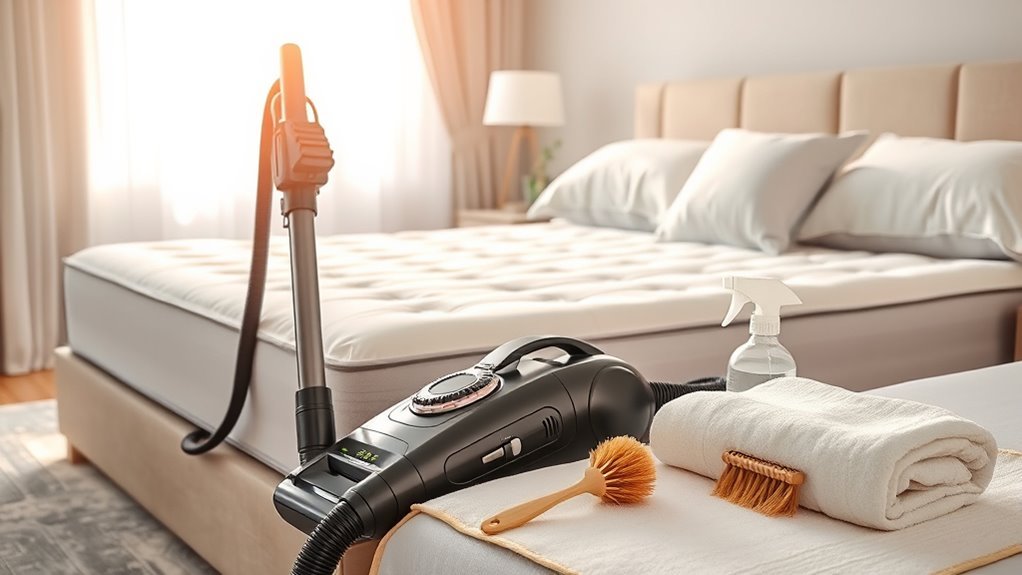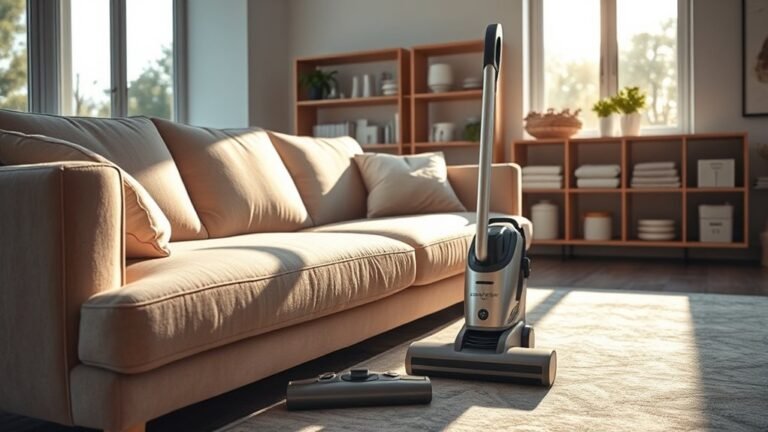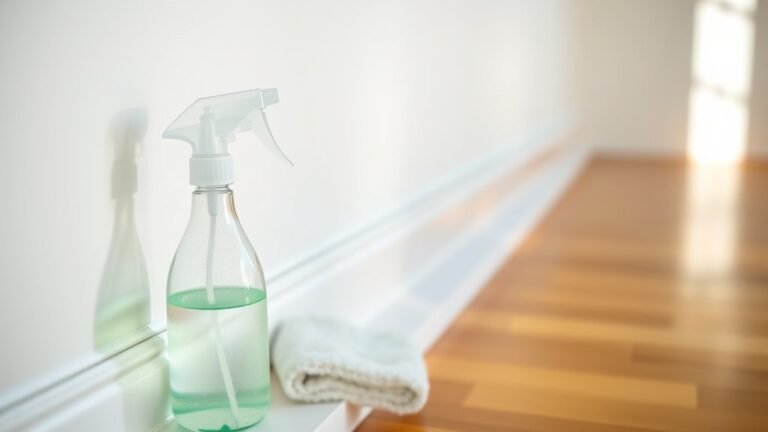Cleaning Techniques for Mattress Owners
To keep your mattress clean, start by identifying stains—use cold water for blood and enzymatic cleaners for urine. Vacuum thoroughly with a HEPA-filter vacuum, focusing on seams and flipping the mattress. Sprinkle baking soda mixed with essential oils to absorb odors, then vacuum after a few hours. For deeper cleaning, use a steam cleaner without soaking the mattress. Protect against allergens with encasements and regular hot washing of bedding. Follow these practical steps for a fresh, healthy mattress, and you can explore more detailed care tips ahead.
Identifying Common Mattress Stains and How to Treat Them
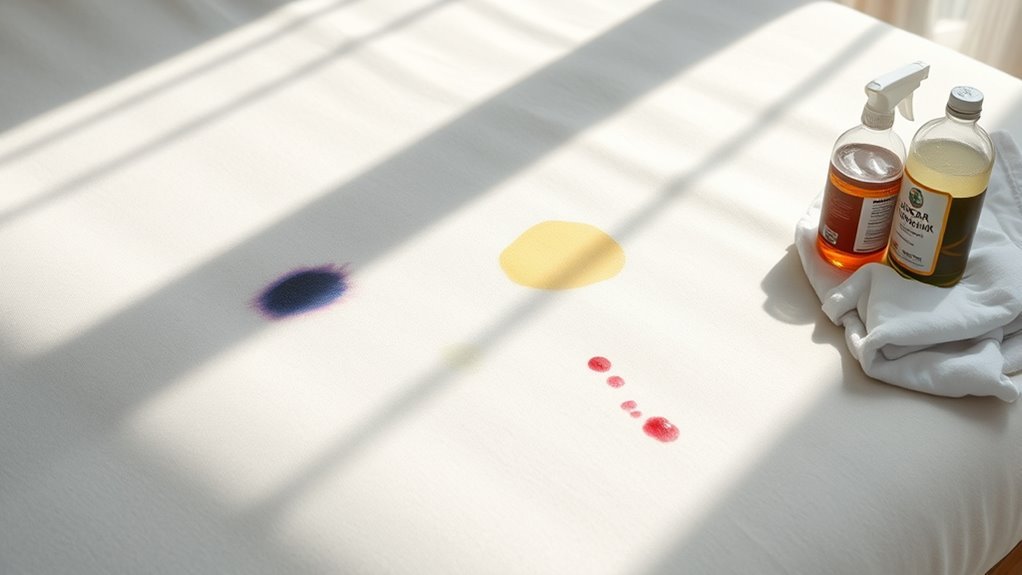
Although mattress stains can seem overwhelming at first, identifying the type of stain is essential for effective treatment. When you spot blood stains, act quickly—cold water and a gentle blotting technique prevent setting. Avoid hot water, which can make stains permanent. For urine stains, it’s important to neutralize odors and bacteria. Use an enzymatic cleaner specifically designed for urine; it breaks down proteins to eliminate both marks and smells. You’ll want to test any cleaner on a small, hidden area first to avoid damage. Recognizing the stain type helps you select the right cleaning agent and method, ensuring your mattress stays fresh without harsh chemicals. Taking these steps lets you reclaim your space confidently and enjoy a cleaner, healthier sleep environment. Immediate action is crucial for effective cleaning because it prevents stains from setting, making removal easier.
Step-by-Step Guide to Vacuuming Your Mattress
Vacuuming your mattress thoroughly involves five key steps to guarantee you remove dust, allergens, and debris effectively. First, gather essential vacuuming tools: a vacuum cleaner with a HEPA filter and upholstery attachment. Second, strip all bedding to access the mattress surface fully. Third, use slow, overlapping strokes with the upholstery attachment, focusing on seams and edges where dust accumulates. Fourth, flip the mattress and repeat the process to clean both sides. Finally, vacuum the mattress base and any crevices. These mattress vacuuming techniques guarantee deep cleaning, reducing allergens and extending your mattress’s life. By following this step-by-step guide, you’ll reclaim control over your sleep environment, enjoying freedom from irritants and a fresher, healthier mattress. For added freshness and odor control, consider using natural essential oil blends after vacuuming.
Using Baking Soda and Essential Oils for Odor Removal
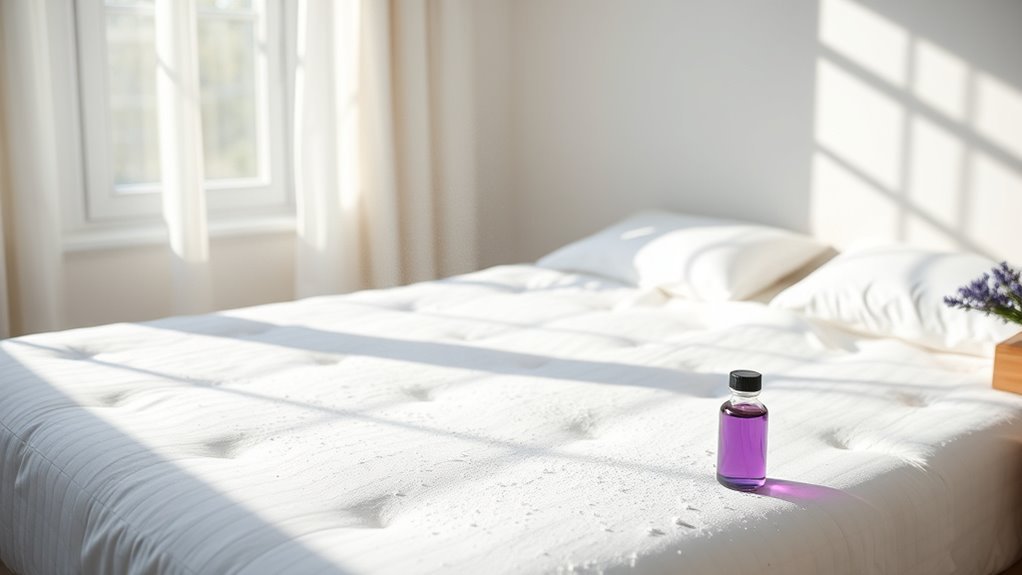
You’ll find baking soda is excellent at absorbing moisture and neutralizing odors trapped in your mattress fibers. To enhance this effect, add a few drops of your favorite essential oil, like lavender or eucalyptus, which not only freshen the scent but also offer antibacterial properties. Simply sprinkle the mixture evenly, let it sit for several hours, then vacuum thoroughly to remove residues and lingering smells.
Baking Soda Benefits
A simple yet effective solution for freshening up your mattress involves using baking soda combined with essential oils. Baking soda acts as a natural deodorizer, absorbing unpleasant odors and moisture without harsh chemicals. Here’s how you benefit:
- Odor Neutralization: Baking soda traps and neutralizes smells, leaving your mattress fresher.
- Moisture Absorption: It soaks up excess moisture, reducing mildew risk and prolonging mattress life.
- Gentle and Safe: Unlike synthetic products, baking soda is non-toxic and safe for your skin and respiratory system.
To use, sprinkle a generous layer of baking soda evenly over the mattress surface. For enhanced freshness, add a few drops of your favorite essential oils to the powder before application. Let it sit for several hours, then vacuum thoroughly. This method gives you a clean, odor-free mattress effortlessly, supporting your freedom to enjoy restful sleep.
Essential Oils Usage
Although baking soda alone effectively neutralizes odors, combining it with essential oils enhances the freshness and leaves a pleasant scent on your mattress. To do this, start by mixing about 20 drops of your preferred essential oils—like lavender or eucalyptus—with one cup of baking soda. These essential oils not only add a natural fragrance but also deliver aromatherapy benefits, promoting relaxation and well-being. Sprinkle the scented baking soda evenly across your mattress surface, then let it sit for at least an hour, or longer if possible. Afterward, vacuum thoroughly to remove the powder and trapped odors. This method is simple, effective, and grants you freedom from harsh chemicals while maintaining a fresh, inviting sleeping environment.
How to Deep Clean Your Mattress With Steam
Because steam penetrates deep into mattress fibers, it’s one of the most effective ways to eliminate dust mites, bacteria, and allergens. To deep clean your mattress with steam, follow these practical steps for ideal mattress hygiene:
- Prepare your steam cleaner, ensuring it’s filled with distilled water to prevent mineral buildup.
- Slowly move the steam cleaner over the mattress surface, allowing the steam to saturate the fibers without soaking them.
- After steaming, let the mattress air dry completely to avoid moisture-related issues.
Steam cleaning not only refreshes your mattress but also provides a chemical-free way to maintain mattress hygiene. By regularly deep cleaning with steam, you gain freedom from allergens and promote a healthier sleeping environment without harsh cleaners. For best results, maintaining a regular cleaning schedule helps prevent buildup and keeps your mattress fresh longer.
Tips for Preventing Mattress Allergens and Dust Mites
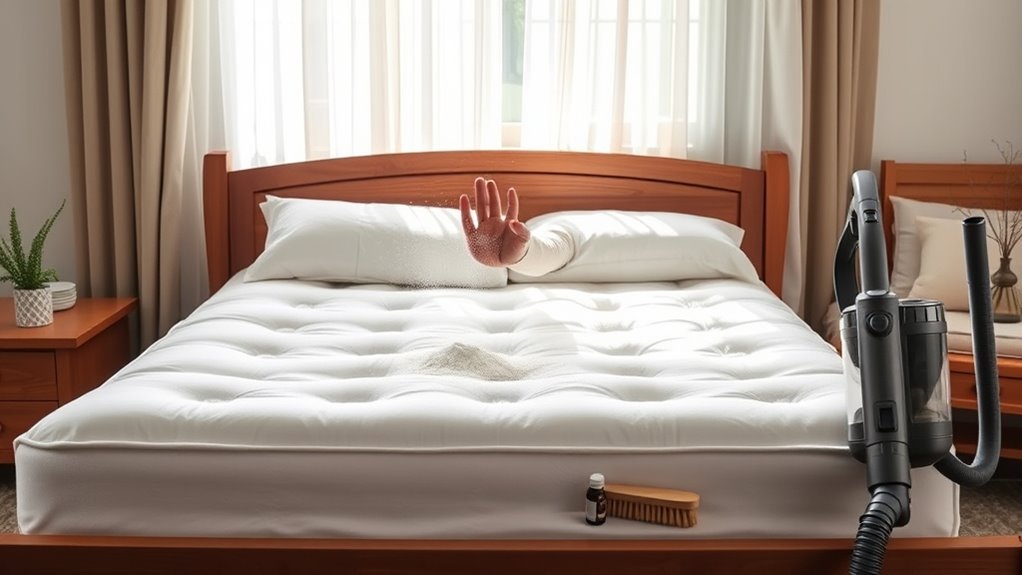
Preventing mattress allergens and dust mites starts with consistent habits and targeted strategies that you can easily incorporate into your routine. First, invest in high-quality mattress encasements designed to block dust mites and allergens effectively. These create a barrier, reducing your exposure and aiding allergy prevention. Regularly wash bedding in hot water to eliminate allergens before they settle. Keep humidity low in your bedroom since dust mites thrive in moist environments; a dehumidifier or air conditioner can help maintain dryness. Vacuum your mattress periodically using a vacuum with a HEPA filter to capture fine particles. Finally, avoid eating or drinking in bed to prevent crumbs that attract dust mites. Additionally, using microfiber cloths for wiping down surfaces in your bedroom can help reduce the spread of allergens and pet hair, contributing to a cleaner sleeping environment. By following these practical steps, you’ll maintain a cleaner, allergen-reduced mattress, enhancing your sleeping freedom and comfort.
Best Practices for Regular Mattress Maintenance
When you commit to regular mattress maintenance, you extend its mattress lifespan and guarantee a healthier sleep environment. To maintain freedom from allergens and wear, follow these best practices:
- Stick to a cleaning frequency: Vacuum your mattress every one to two months to remove dust, mites, and debris.
- Rotate and flip: Turn your mattress every three months to prevent uneven wear and sagging.
- Spot clean immediately: Address spills or stains as soon as they happen using mild detergent and water to avoid long-term damage. Incorporating natural alternatives like white vinegar can help break down stains while keeping the mattress fresh without harsh chemicals.
Frequently Asked Questions
How Often Should I Replace My Mattress for Health Reasons?
Replacing your mattress is like changing the oil in your car—it keeps everything running smoothly. The average mattress lifespan is about 7-10 years, but health implications like allergies or poor sleep quality might push you to replace it sooner. You’ll want to assess comfort and cleanliness regularly; if you notice sagging or increased allergies, it’s time for a new one. Staying proactive helps you maintain freedom from discomfort and health issues.
Can Mattress Covers Affect Cleaning Effectiveness?
Yes, mattress cover materials can impact cleaning effectiveness. Some covers, like waterproof or hypoallergenic fabrics, shield against spills and allergens, reducing how often you need deep cleaning. However, they might trap moisture if not breathable, so regular washing per cleaning frequency recommendations is essential. You’ll want to balance protection with airflow to maintain freshness. Choosing the right cover helps you clean smarter, not harder, giving you freedom from constant mattress maintenance.
Are There Eco-Friendly Mattress Cleaning Products Available?
You want effective cleaning, you want safe cleaning, you want eco friendly options—and yes, you can find them. Many mattress cleaning products now use natural ingredients like baking soda, vinegar, and essential oils, offering powerful stain removal without harsh chemicals. These eco-friendly options not only protect your mattress but also the environment, giving you the freedom to clean thoroughly and responsibly. Look for labels emphasizing biodegradable formulas and non-toxic components for the best results.
How Do Cleaning Methods Differ for Memory Foam Mattresses?
When you care for memory foam, you need gentle cleaning tips to preserve its structure. Unlike traditional mattresses, avoid soaking it; instead, spot clean with a mild detergent and water. Use a spray bottle for precise application and blot, don’t rub, to prevent damage. Always let it air dry completely to avoid mold. These steps let you maintain freshness while keeping your freedom to enjoy a comfy, long-lasting memory foam mattress.
Is Professional Mattress Cleaning Worth the Cost?
Did you know that a professionally cleaned mattress can last up to 50% longer? When you weigh the cost benefits, professional services often save you money in the long run by preventing allergens and wear. While the upfront price might seem high, these thorough cleanings use specialized equipment you wouldn’t have at home. If you value freedom from frequent replacements and want a healthier sleep environment, investing in pros is a smart, practical choice.
